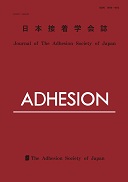All issues

Volume 41, Issue 2
Displaying 1-5 of 5 articles from this issue
- |<
- <
- 1
- >
- >|
Review
-
Shigeru AIDA2005Volume 41Issue 2 Pages 67-71
Published: February 01, 2005
Released on J-STAGE: September 30, 2015
JOURNAL FREE ACCESSDownload PDF (1548K)
Review
-
Akira SHINTAI2004Volume 41Issue 2 Pages 60-66
Published: February 01, 2004
Released on J-STAGE: September 30, 2015
JOURNAL FREE ACCESS
Original Paper
-
Masaki KIMOTO, Ayako HIOKI, Hideki HASHIMOTO2005Volume 41Issue 2 Pages 54-59
Published: February 01, 2005
Released on J-STAGE: November 30, 2014
JOURNAL FREE ACCESSSilica micro-spheres were synthesized by using NH3 as a catalyst in hydroxypropylcellulose (HPC) solution through the hydrolysis and condensation polymerization of tetraethoxysilane.The surface compositions of the obtained particles were analyzed qualitatively by using X-ray photoelectron spectroscopy (XPS).The nitrogen gas adsorption, the specific surface area measurements, and the transmission electron microscope (TEM) observations were carried out for the calcined particles.From the XPS results, it was concluded that HPC molecules were chemically adsorbed on the surfaces of the silica particles.For the calcined particles, meso-pores were formed after decomposition of the adsorbed HPC.The adsorption of the N2 gas and the specific surface area increased as increasing HPC added in the synthes is of the particles.The effect of HPC addition on increase of the specific surface area was remarkable in the case when n-butanol was used as solvent rather than ethanol.These results could be explained by the extent of the interaction between HPC and silica precursor.It was also examined for the particle formation and growth mechanism in the HPC solutions.View full abstractDownload PDF (1656K)
Original Paper
-
Takashi NISHINO, Ken HIROTOMI2005Volume 41Issue 2 Pages 49-52
Published: February 01, 2005
Released on J-STAGE: November 30, 2014
JOURNAL FREE ACCESSMaleicanhydridewasgraftedtoultra-highmolecularweightpolyethylene(UHMWPE)insemi-dilutesolution:thengelcastfilmwasobtainedbyquenchingthesolution.Thesurfaceandmechanicalpropertiesoftheultra-drawnUHMWPEgelcastfilmwasinvestigatedusinginfraredspectroscopy,dynamiccontactanglemeasurements,tensiletest,and90degreepeelstrength.Thesurfaceofulti、a-drawnfilmbecamehydrophilicthroughgraftingfollowedbyultradrawinginboilingwater、;insteadofpost-surfaceti、eatment・The90degreepeelstrengthbetweentheepoxyresinandthisultra-drawnfilmincreased6timescomparedwiththatofthecontrol.Bycontrollingtheamountofgraftedmaleicanhydride,theUHMWPEfilmwithhighmechanicalperformanceandhighadhesivestrengthwasobtained.(View full abstractDownload PDF (1454K)
Original Paper
-
Guangda Shi, Lawrence T Drzal2005Volume 41Issue 2 Pages 42-48
Published: February 01, 2005
Released on J-STAGE: November 30, 2014
JOURNAL FREE ACCESSThe effect of matrix properties on the fiber to polymer adhesion in a model cellulose fiber reinforced composite system was studied.Pure polypropylene (PP) of different mechanical properties (tensile and shear modulus) were used to form adhesion samples with a regenerated cellulose fiber (TencelR) and tested using the microbond adhesion test.The adhesion between the cellulose fiber and pure PP were related to the shear-lag stress transfer model proposed by Cox.It was found that if chemical bonding is not present at the fiber-matrix interface, interfacial adhesion can be directly related to the product of matrix strain and the square root of the matrix shear modulus.Since polypropylene is a semi-crystalline polymer, however, care must be taken to include the effect of matrix crystallinity.When maleic anhydride grafted polypropylene (maPP) was introduced at the fiber-matrix interface, the interfacial adhesion was significantly higher than for the comparable cellulose fiber and purepolypropylene system.The increase in the interfacial adhesion is attributed to the formation of covalent bonds between the cellulose fiber and the maPP matrix.View full abstractDownload PDF (2129K)
- |<
- <
- 1
- >
- >|